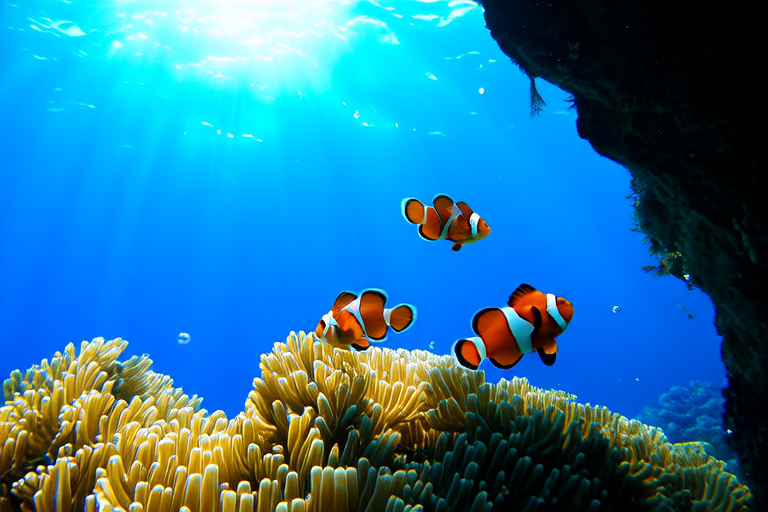Clownfish Companions: Secrets to Success in Saltwater Aquariums
Clownfish have captured the hearts of many aquarists, both novice and seasoned, with their vibrant colors and playful personalities. These fish are not only a joy to watch but also relatively easy to care for, making them a popular choice for saltwater aquarium enthusiasts. From the iconic orange-and-white stripes of the common clownfish to the more exotic patterns of lesser-known species, there’s a clownfish to suit every taste.
Natural Habitat and Behavior
Native to the tropical waters of the Indian and Pacific Oceans, clownfish live in close association with sea anemones, which serve as both a protective shelter and a food source. The symbiotic relationship between clownfish and anemones is fascinating; the fish are immune to the anemone’s stinging tentacles, while the anemone benefits from the clownfish’s presence by being cleaned and protected from predators.
Clownfish are social creatures, often found in small groups or pairs within their natural habitat. They exhibit territorial behavior, defending their territory against other clownfish. This social structure can be replicated in a saltwater aquarium, where they thrive in pairs or small groups.
Factors Crucial for Their Well-being in Captivity
Understanding the specific requirements of clownfish is essential for their well-being in captivity. A stable water environment, proper nutrition, and appropriate companions are key factors that contribute to their health and happiness.
Setting Up an Ideal Tank Environment
The first step in creating a suitable environment for your clownfish is selecting an appropriately sized tank. Clownfish require at least 20 gallons of water per pair, with larger tanks offering more space for swimming and exploration. A well-maintained filtration system and regular water changes are vital for maintaining water quality.
Clownfish also benefit from a varied substrate and rockwork arrangement that mimics their natural habitat. Providing hiding spots and caves encourages natural behaviors and reduces stress. Anemones, though not always necessary, can enhance the aesthetic appeal of the tank and offer a familiar environment for the fish.
Suitable Tankmates
Choosing compatible tankmates is crucial for the well-being of your clownfish. Clownfish generally get along well with peaceful, non-aggressive species. Avoid placing them with overly aggressive or territorial fish, such as triggerfish or pufferfish. It’s also important to consider the size and temperament of any potential tankmates, ensuring that they will not outcompete or intimidate the clownfish.
Dietary Needs
Clownfish are omnivores, meaning they eat both plant and animal matter. In the wild, they feed on algae, zooplankton, and small invertebrates. In captivity, it’s essential to provide a balanced diet that includes high-quality flake foods, frozen foods, and occasional fresh vegetables. Feeding schedules should be consistent, and portions should be adjusted according to the number of fish and the size of the tank.
Common Challenges Faced by Hobbyists
Despite their popularity, keeping clownfish in a saltwater aquarium comes with its own set of challenges. One common issue is the difficulty in getting new clownfish to acclimate to their new environment. To help with this, gradually introduce the fish to the tank water over several days, ensuring a smooth transition.
Another challenge is ensuring the right balance of tank mates and avoiding overcrowding. Overcrowded tanks can lead to stress, disease, and aggression among fish. Regular monitoring of water parameters and maintaining a clean environment can prevent these issues.
Breeding Clownfish in Home Aquariums
Breeding clownfish in a home aquarium is a rewarding endeavor for experienced aquarists. Successful breeding requires a well-established tank with optimal water conditions, ample hiding places, and a diverse diet. Pairing compatible clownfish is crucial, as they tend to breed in pairs. Once a pair forms, they will establish a territory and prepare a nest for spawning.
After spawning, the eggs will hatch in about seven to ten days. The fry need to be fed infusoria or newly hatched brine shrimp for the first few weeks. As they grow, they can be introduced to a varied diet similar to adult clownfish. Breeding clownfish not only provides a continuous supply of healthy fish but also contributes to the sustainability of the hobby.
In conclusion, clownfish are delightful additions to any saltwater aquarium. By understanding their natural habitat and behavior, providing a suitable environment, and addressing common challenges, aquarists can ensure the health and happiness of their clownfish companions. Whether you’re a beginner or an expert, the journey of caring for clownfish is filled with joy and discovery.
